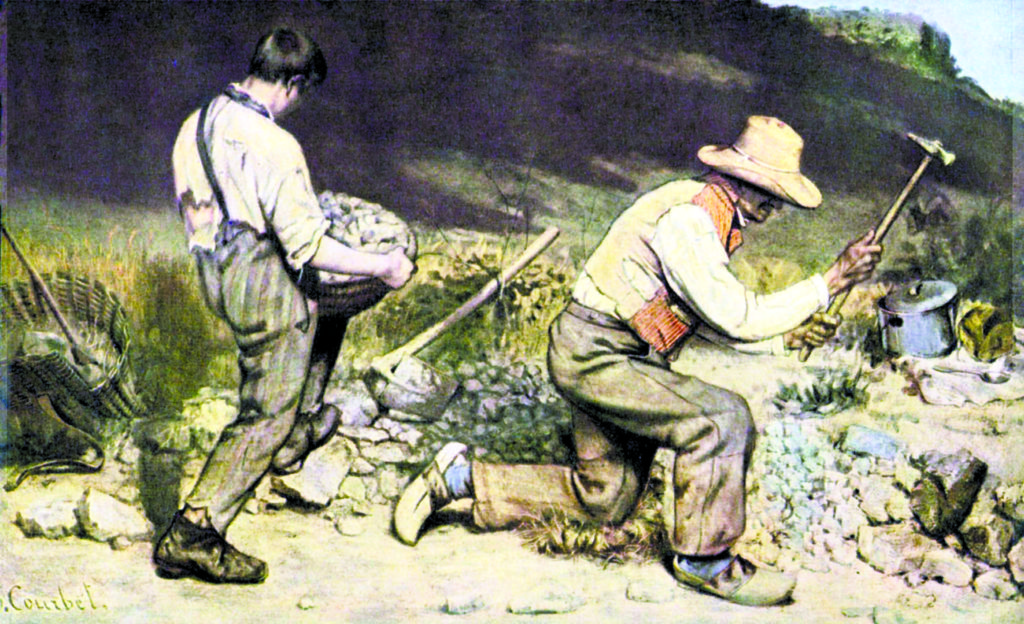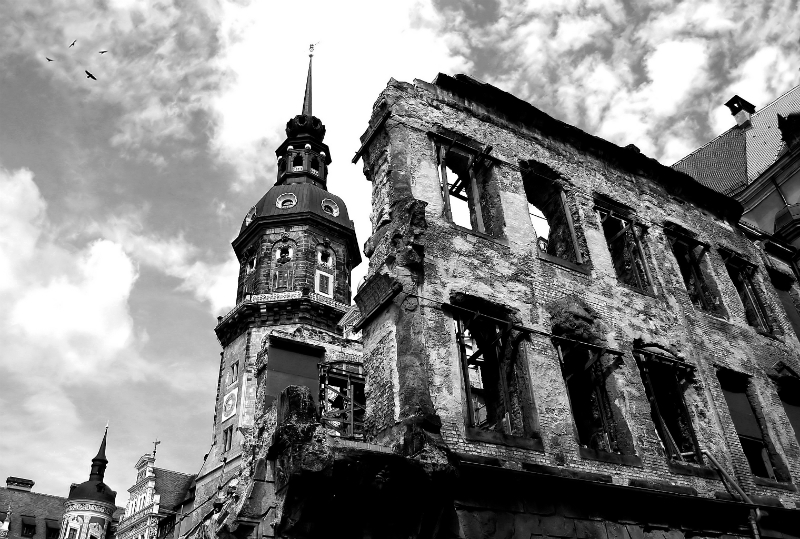Feb. 13, 1945. Dresden was defenceless, its anti-aircraft guns removed to the Eastern Front, the Luftwaffe, Germany’s air force, decimated. There was not a single reinforced, ventilated shelter in the city, except for high-level Nazis and the SS.
At 10:03 p.m., a single Royal Air Force (RAF) Lancaster bomber dropped a green bomb to mark the aiming point, a stadium. It and others dropped flares to completely light up the city. Mosquito bombers, swooping down from 20,000 feet, dropped red flares that lit a path for 244 Lancasters that followed, carrying four- pound magnesium incendiary bombs and 4,000-pound blast bombs. Only 10 German fighters engaged them. The British could jam their radar. No British planes were shot down.
Incendiaries rained down in the tens of thousands. On their own, each one could be put out with a pail of sand. But the inhabitants, sheltering in basements, were unable to get to them. The blast bombs ruptured watermains and blew out the doors and windows of buildings, creating through drafts which, along with the strong wind blowing, fanned the flames.
The bombing was over in 20 minutes, but three hours later, 524 Lancasters – 67 Canadian – returned. First responders on the scene were killed. Thousands of little fires came together and created an inferno 100 metres tall, 1,000 degrees Celsius at the top, sustaining itself by drawing in all the surrounding oxygen, creating gale force winds that sucked anyone nearby into the flames. People in basement shelters inhaled carbon monoxide. Deprived of oxygen, they died. Streets turned into tar. People fleeing got stuck. Incinerated, mummified corpses were glued to the asphalt. Lampposts melted. Desperate people jumped into cement-lined reservoirs. Eventually the water got hot. Unable to get out, they cooked to death.
Thirty magnificent buildings – palaces, churches, museums, an opera house, constituting one of the most impressive collections of architecture in the world, built over three centuries in styles ranging from Renaissance through Baroque to Roccoco and neo-Classical – were either destroyed or severely damaged. The 1734 Frauenkirche, the most beautiful Protestant ecclesiastical building of the 18th century with superb acoustics and an organ built by Silbermann, the Stradivarius of organ makers (its inaugural soloist was Johann Sebastian Bach), collapsed.
But the 1840 Semper Synagogue, named after its famous architect, Romanesque exterior, Alhambresque interior, the most beautiful in Germany, could not be destroyed. That had happened on Kristallnacht.
These 7,428 tons of bombs would not be the end of it. The following day the U.S. dispatched 417 (or 461, depending on which historian you believe) B-17 bombers escorted by 784 P-51 Mustang fighters against the Dresden train marshalling and repair yards, a target of military value, to stop German resupply of its Eastern Front 75 kilometres away. Only 316 bombers (or 311) arrived and dropped 782 tons of bombs. The other bombers and their escorts got lost and bombed Prague, 117 kilometres away, by mistake. The following day, American bombers sent to target a synthetic oil plant couldn’t locate it because of fog, so bombed the rubble of Dresden instead.
Thousands of corpses were dumped in the town square and set on fire to prevent the spread of disease. Thirty-four square kilometres of the city were obliterated.
The last official wartime record put the number of dead at 22,096, though 1,800 more were unearthed as the city was rebuilt. With soldiers at the front, most of these were civilians, the primary targets of most British air raids up to that point. How could such a policy have been tolerated, even against civilians for the most part willingly and slavishly following a foaming at the mouth monster?
The British did not have a problem with targeting civilians. They won the Boer War by inventing the concentration camp. During the First World War they instituted a naval blockade that treated food like war materiel. But this time the Luftwaffe started it: the bombing raids on Guernica, Warsaw, Rotterdam, London and Coventry were attempts to bring the other side to its knees by terrifying non-combatants and destroying morale. Arthur “Bomber” Harris, who became head of RAF Bomber Command in February 1942, quoted Hosea 8:7: “They have sown the wind and they will reap the whirlwind.”
When the war started, the RAF could not reliably navigate anywhere, let alone drop a bomb on a precision military target. The Butt Report of August 1941 found that only one-third of pilots who reported attacking an assigned target had bombed within eight kilometres. It was one-fifteenth on moonless nights.
To bomb anything they had to bomb everything.
By contrast, the U.S. Air Force (USAF) believed in precision bombing of military targets. Its pilots, therefore, flew daytime raids in B-17s which had many guns, thinking that in tight formation they could ward off German fighters. They couldn’t.
On a clear and sunny Aug. 17, 1943, for example, the USAF’s 100th Bombardment Group, led by Curtis LeMay, attacked the Messerschmitt factory in Regensburg, losing nine of 21 planes. In October of that year, 26 per cent of planes attacking the ball bearing factory in Schweinfurt were lost. This was unsustainable
Meanwhile, Harris, backed by Prime Minister Winston Churchill, continued pulverizing German cities by night, thinking he could break German morale and end the war. He couldn’t. In November 1943, he launched what would total 35 major missions comprising 20,244 sorties against Berlin, claiming the loss of 400-500 planes would “cost Germany the war.” By March 1944, 1,047 had been shot down, 1,682 damaged and the war raged on according to P.P. O’Brien’s How the War was Won. By the time Harris got to Dresden, Germany’s major cities had been severely bombed, yet it was still fighting tenaciously. (Germans couldn’t exactly write their MPs demanding an end to the war.)
The Americans, however, understood the key to victory: destroying the Luftwaffe. To do that they built agile fighter planes with enough range to accompany bombers anywhere in Germany. They decimated the Luftwaffe’s fighters and controlled the skies by the spring of 1944, enabling destruction of bridges and other transport infrastructure in Normandy, without which, the invasion might have been repulsed. U.S. bombers then went after German key industries, synthetic oil plants and, importantly, transportation infrastructure without which coal could not be delivered to factories thus rendering them idle. Anything produced could not be shipped to where it was needed.
The collection of Dresden’s art museum, one of the world’s most important, was removed to various nearby castles at the start of the war. As the Russians approached, the collection in one of the easternmost castles, Schloss Milkel, was to be moved to Schloss Schieritz, north of Dresden.

Feb. 13 was Fasching, a German Mardi Gras, a party day. Thomas Rudert, provenance expert of Staatliche Kunstsammlungen Dresden, told me that the driver, instead of going to Schloss Schieritz, detoured to Dresden, parked his truck, went to party with his girlfriend and the bombing started. Hundreds of Old Masters were incinerated: Bordone, Pieter Breughel, Elder and Younger Cranach, van Dyck, Giordani, Giorgone, Durer, Rubens, Tintoretto to name just the best. Also destroyed was Gustave Courbet’s Les casseurs des pierres (The Stone Breakers).
Two hundred Dresden Jews had not yet been murdered, because they were married to Aryans. Half survived the bombing. The SS building along with its records was destroyed. They tore off their Stars of David and joined the tens of thousands now homeless. The most famous of these was Victor Klemperer, who in 1933 began, as an act of defiance, a diary that he continued until his death in 1961. His daily, real-time recording of life under the Third Reich is fascinating. That day, he recorded he was given the job of delivering notices to some of the remaining Jews to assemble on the 16th for “transportation.” He closely observed and described the agonized reaction of each recipient.
The war was almost over, but no one knew it at the time. The Germans had just launched the huge, if unsuccessful, Ardennes Offensive, were inflicting hundreds of thousands of Allied casualties monthly and were the only side with operational rockets, jet planes and a Schnorkel submarine.
It is incorrectly argued Dresden was not a military target. It had 127 enterprises designated by a code, indicating their military importance to Germany. The largest, Zeiss-Ikon, employing 14,000, made military lenses and fuses. These outlying factories, many using forced labour, though not the target, were damaged. Harris said that if he burnt a factory they rebuilt it in six months but replacing a worker took 21 years.
Dresden was a city of immense cultural importance. It wasn’t just the architecture. In Meissen, just to the north of the city, in 1710, two Europeans figured out the formula for making Chinese porcelain. In Dresden in 1905, Ernst Kirchner began Die Brucke, forerunner of German Expressionism. Otto Dix and Oskar Kokoschka taught at the Dresden Academy. Dresden’s opera continued its high standards throughout the war and when the post of conductor became vacant, Herbert von Karajan, a Nazi since 1935, tried to get appointed.
But what good was Germany’s contribution to the canon of Western Civilization if Germany was perpetrating the Holocaust?
High culture continued full throttle during the war, both to show the superiority of the German race and (along with low culture) to mask the barbarism and pretend everything was normal. This is telescoped in a Rundschrieben of the Auschwitz administration published by Sybille Steinbacher and co-authors. It announced a performance at the Auschwitz village set up for SS guards on Feb.9, 1943 of Goethe. “They (the Volksdeutsche) should know in particular, that the German culture, of which the entire world speaks,… is most of all the artistic expression of the feelings of our poets and thinkers.” A search I commissioned in the archives of the Dresden Staatstheater revealed that the leads in the Auschwitz Goethe were an acclaimed singer of the Dresden opera and an honoured actor of the Dresden Staatstheater.
SS guards could attend Goethe in the evening, return next morning to their regular jobs murdering 216,000 Jewish and 11,000 Sinti and Roma children and go home at night to their own adored children, living with them at Auschwitz. As Dante wrote seven centuries ago in “Canto XXVIII” of a different Inferno:
It’s certain no human tongue could take the measure
Of those enormities. Our speech and mind,
Striving to comprehend them, flail and falter.
Murray Teitel is a Toronto art critic. Translation from The Inferno of Dante by Robert Pinsky, 1994, Strauss, Farar and Giroux. In addition to people already named, the author thanks Ilana Arnold for help with research and Lisa Dietrich for translating the Rundschrieben and emails of experts who wrote to him in German.
